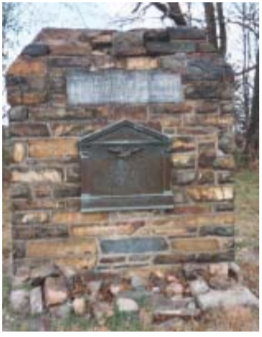Carolina Back Country Timeline: The American Revolution
Allred Involvement Noted By Red Star
The Distance Between Allred Land and Some Battlefields Also Noted
by: Alice Allred Pottmyer
First published in the Allred Family Newsletter, Issue #95, Summer 2013
 Keep in mind the War happened 250 years ago and some documentation no longer exists. Yes, we have documentation to prove some Allreds were at some battles/skirmishes. BUT, just because there is no documentation to prove our Allred ancestors were not involved in certain battles/skirmishes, doesn't mean they weren't there. Consider how close they lived to some of these sites. Consider they knew what was going on and MAYBE they went to help...maybe... What would you do if you were standing in their shoes?
Keep in mind the War happened 250 years ago and some documentation no longer exists. Yes, we have documentation to prove some Allreds were at some battles/skirmishes. BUT, just because there is no documentation to prove our Allred ancestors were not involved in certain battles/skirmishes, doesn't mean they weren't there. Consider how close they lived to some of these sites. Consider they knew what was going on and MAYBE they went to help...maybe... What would you do if you were standing in their shoes?
 May 1771—Alamance, North Carolina: Prior to the revolution, backcountry farmers (known as Regulators because they wanted to regulate the unfair taxation policy) battled the British Royal Governor Tryon’s Troops. Several Allreds were involved in the Battle of Alamance. 22 Miles Away From Allred Land
May 1771—Alamance, North Carolina: Prior to the revolution, backcountry farmers (known as Regulators because they wanted to regulate the unfair taxation policy) battled the British Royal Governor Tryon’s Troops. Several Allreds were involved in the Battle of Alamance. 22 Miles Away From Allred Land
May 1780—Charleston, South: Carolina Fall of Charleston to the British.
May 1780—Bufford’s Massacre, South Carolina: Retreating American troops slain by Col. Banastre Tarleton’s troops earned him the nickname “Bloody Tarleton.”
June 1780—Ramsour’s Mill, North Carolina: Outnumbered almost 3 to 1, the Patriots routed the Loyalists, prior to Lord Cornwallis’ move into North Carolina.
July 1780—Huck’s Defeat, South Carolina: Patriots from both Carolinas surround and destroy 150 loyalists under Capt. Christian Huck. This victory, a major morale booster, sparked the beginning of the end of British fortunes in the Carolinas.
August 1780—Hanging Rock South Carolina: On August 1, Maj. William R. Davie routed a British force, followed by Sumter’s August 6 attack culminating in a draw.
August 1780—Camden, South Carolina: Decisive British victory under Lord Cornwallis. Preparations now made to
move into North Carolina.
August 1780—Fishing Creek, South Carolina: “Bloody Tarleton” strikes again killing 150 patriots.
September 1780—Charlotte, North Carolina: Lord Cornwallis occupies Charlotte after heated skirmish with Patriots under Maj. Davie. 92 Miles Away From Allred Land
October 1780—Kings Mountain, South Carolina: A decisive victory for Patriot forces over Major Patrick Ferguson. This battle was the first link in a chain of events that led to the final defeat of the British.
November 1780—Fishdam Ford, South Carolina: Gen. Sumter’s Patriots inflict heavy casualties on troops, 25 miles from British headquarters in Winnsboro.
November 1780—Blackstocks, South Carolina: Gen. Sumter’s men defeat Col. Tarleton and his men. Gen. Sumter was wounded.
December 1780—Charlotte, North Carolina: American General Nathaniel Greene takes command of the Southern troops from General Horatio Gates. 92 Miles from Allred Land
January 1781—Cowpens, South Carolina: General Daniel Morgan brilliantly deployed the Patriot force at a regional
livestock gathering area known as the “cow” pens. They soundly defeated the British under Col. Banastre Tarleton. This was Col. Tarleton’s first major defeat.
 February 1781—Trading Ford, North Carolina: On February 2-3, the Patriot forces under Gen. Greene, crossed the Yadkin River seven miles from Salisbury. Under cold and rainy conditions, 1,800 men and supplies crossed the river. About 150 North Carolina and Virginia riflemen were held back to engage the British Forces of Lord Cornwallis if they appeared. At dark, British forces appeared and were surprised by the Patriots. They “fired two rounds” and then got onto the remaining flat boats and canoes and crossed the river. The next morning, the river had risen two feet and was too high and swift to cross. Four Allred men were part of the North Carolina unit that engaged the British. 52 Miles from Allred Land
February 1781—Trading Ford, North Carolina: On February 2-3, the Patriot forces under Gen. Greene, crossed the Yadkin River seven miles from Salisbury. Under cold and rainy conditions, 1,800 men and supplies crossed the river. About 150 North Carolina and Virginia riflemen were held back to engage the British Forces of Lord Cornwallis if they appeared. At dark, British forces appeared and were surprised by the Patriots. They “fired two rounds” and then got onto the remaining flat boats and canoes and crossed the river. The next morning, the river had risen two feet and was too high and swift to cross. Four Allred men were part of the North Carolina unit that engaged the British. 52 Miles from Allred Land
February 1781—Cowans’ Ford, North Carolina: Lord Cornwallis’ troops crossed at Cowan’s Ford and the Patriots under Gen. Davidson tried to stop them. Davidson was killed and the Americans broke ranks and fled. 83 Miles from Allred Land.


